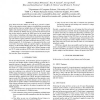140 search results - page 3 / 28 » On using Articulatory Features for Discriminative Speaker Ad... |
ICASSP
2010
IEEE
13 years 5 months ago
2010
IEEE
Existing large-scale articulatory databases describe the tongue shape through the 2D positions of 3–4 fixed landmarks on the tongue surface. The ability to reconstruct the full...
ICASSP
2009
IEEE
13 years 3 months ago
2009
IEEE
In an attempt to overcome problems associated with articulatory limitations and generative models, this work considers the use of phonological features in discriminative models fo...
ICASSP
2011
IEEE
12 years 9 months ago
2011
IEEE
Deep Belief Networks (DBNs) are multi-layer generative models. They can be trained to model windows of coefficients extracted from speech and they discover multiple layers of fea...
INTERSPEECH
2010
13 years 3 days ago
2010
In the paper we present two techniques improving the recognition accuracy of multilayer perceptron neural networks (MLP ANN) by means of adopting Speaker Adaptive Training. The us...
AVBPA
2001
Springer
13 years 9 months ago
2001
Springer
: We consider the matching function in vector quantization based speaker identification system. The model of a speaker is a codebook generated from the set of feature vectors from ...

